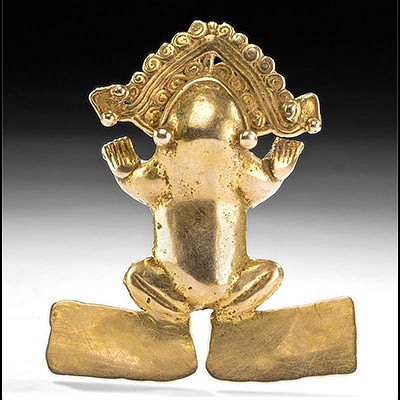Cocle Polychrome Pottery Coatimundi Vessel
Lot 97
About Seller
Artemis Fine Arts
686 S Taylor Ave, Ste 106
Louisville, CO 80027
United States
Selling antiquities, ancient and ethnographic art online since 1993, Artemis Gallery specializes in Classical Antiquities (Egyptian, Greek, Roman, Near Eastern), Asian, Pre-Columbian, African / Tribal / Oceanographic art. Our extensive inventory includes pottery, stone, metal, wood, glass and textil...Read more
Categories
Estimate:
$3,500 - $5,000
Absentee vs Live bid
Two ways to bid:
- Leave a max absentee bid and the platform will bid on your behalf up to your maximum bid during the live auction.
- Bid live during the auction and your bids will be submitted real-time to the auctioneer.
Bid Increments
| Price | Bid Increment |
|---|---|
| $0 | $25 |
| $300 | $50 |
| $1,000 | $100 |
| $2,000 | $250 |
| $5,000 | $500 |
| $10,000 | $1,000 |
| $20,000 | $2,500 |
| $50,000 | $5,000 |
| $100,000 | $10,000 |
| $200,000 | $20,000 |
About Auction
By Artemis Fine Arts
Aug 13, 2020
Set Reminder
2020-08-13 10:00:00
2020-08-13 10:00:00
America/New_York
Bidsquare
Bidsquare : Fine Antiquities, Ethnographic & Fine Art
https://www.bidsquare.com/auctions/artemis-gallery/fine-antiquities-ethnographic-fine-art-5415
Features classical antiquities, ancient and ethnographic art from cultures encompassing the globe. Egyptian, Greek, Roman, Etruscan, Near Eastern, Asian, Pre-Columbian, Native American, African / Tribal, Oceanic, Spanish Colonial, Russian, Fine Art, so much more! Artemis Fine Arts info@artemisgallery.com
Features classical antiquities, ancient and ethnographic art from cultures encompassing the globe. Egyptian, Greek, Roman, Etruscan, Near Eastern, Asian, Pre-Columbian, Native American, African / Tribal, Oceanic, Spanish Colonial, Russian, Fine Art, so much more! Artemis Fine Arts info@artemisgallery.com
- Lot Description
Pre-Columbian, Central America, Panama, Gran Cocle, ca. 800 to 1000 CE. A hand-built and highly-burnished polychrome coatimundi effigy vessel with a globular body, a flared neck, and a rounded rim, all upon a concave circular base. The coati's face presents with a red and purple mask-like pattern (appropos for the raccoon-like coati) over bas relief, coffee bean shaped eyes and a pointy nose, with a trio of curvilinear motifs rising up to the forehead and inward hooks across the cheeks, and an open toothy mouth below. Arms are bent at the elbows and resolve in claws placed across the abdomen. Meanwhile two panels with saurian heads occupy the spaces in the crooks of the elbows and two panels with barbed motifs line up vertically between them from chest to abdomen. Truly a masterwork! Size: 9.6" W x 12.375" H (24.4 cm x 31.4 cm)
The raccoon-like coatimundi (or coati) was easily tamed, and its funny antics made it a popular pet among the ancients of the Americas. According to Peterson and Green, "The coati's foraging and playfulness help explain its close associations with agriculture and ritual clowning . . .These are celebrated by traditional cultures from the Southwest United States down through Middle America and appear to have great antiquity." (Jeanette Favrot Peterson with essay by Judith Strupp Green, "Precolumbian Flora and Fauna: Continuity of Plant and Animal Themes in Mesoamerican Art" Mingei International Museum of World Folk Art, 1990, p. 52)
According to scholar Samuel Kirkland Lothrop, "The Gran Cocle culture is a Pre-Columbian archaeological culture that gets its name from the area from which it was based, the now present-day Cocle province of Panama. The Gran Cocle term applies to a loosely studied group of Native American sub-cultures in this region, identified by their pottery styles. The overall period spans a time from 150 B.C. to the end in the 16th century A.D. upon Spanish contact. The most ancient culture is the La Mula period from 150 B.C. to 300 A.D. The La Mula and later Monagrillo and Tonosí pottery styles are identified by their the use of three paint colors which were black, red and white (or cream). The later Cubita style saw the emergence of the use of four colors. The styles of Conte, Macaracas and Joaquín added purple to their palette and this hue ranged from grayish tones to red purple. The use of purple disappeared in the subsequent styles of Parita and El Altillo and the paint style reverted back to the use of three colors. Most notable in the artistic renderings are the overt use of geometric designs." (For more information, see Armand Labbe, "Guardians of The Life Stream: Shamans, Art and Power in Prehispanic Central Panama" - Bowers Museum of Cultural Art, University of Washington Press, 1995)
Provenance: ex- Estate of Dr. Frederick J. Dockstader, New York, New York, USA, acquired before 2000
All items legal to buy/sell under U.S. Statute covering cultural patrimony Code 2600, CHAPTER 14, and are guaranteed to be as described or your money back.
A Certificate of Authenticity will accompany all winning bids.
We ship worldwide and handle all shipping in-house for your convenience.
#156557Repaired from a few large pieces, with restoration to areas of neck and body, and resurfacing with overpainting along new material and break lines. Nicks to head, body, and base, with light encrustations within interior. Fabulous remains of original pigment throughout. Old inventory number written in black ink on base.Condition
- Shipping Info
-
All shipping is handled in-house for your convenience. Your invoice from Artemis Gallery will include shipping calculation instructions. If in doubt, please inquire BEFORE bidding for estimated shipping costs for individual items.
-
- Buyer's Premium



 EUR
EUR CAD
CAD AUD
AUD GBP
GBP MXN
MXN HKD
HKD CNY
CNY MYR
MYR SEK
SEK SGD
SGD CHF
CHF THB
THB














